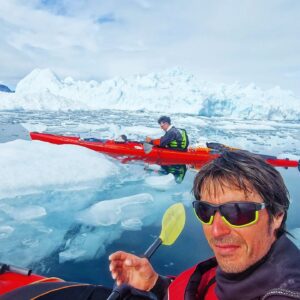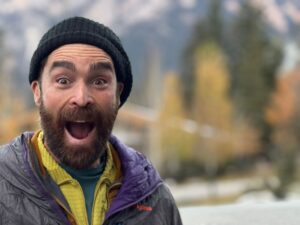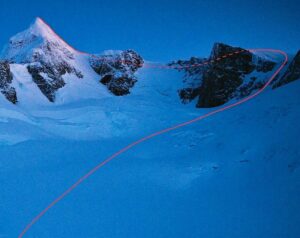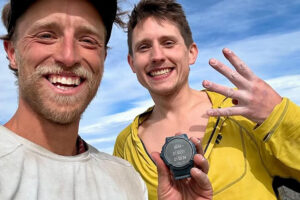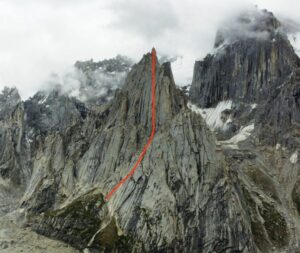When Sean Villanueva O’Driscoll, Nico Favresse, Siebe Vanhee, and photographer Drew Smith announced they were off to the Central Tower of Torres del Paine to free climb the 38-pitch, 1,300m-long Riders on the Storm last month, it was clearly “The” expedition of the season in Patagonia. When weeks went by without news, we sort of lost hope. Patagonia’s vicious weather can foil even the best teams.
But this iron-willed foursome came ready to wait out storm after storm, hanging from a portaledge, armed with patience, music, and skills enough to jump again on the frozen stone as soon as the wind receded a bit. After some days of rumors, the result became public this week.
“February 9, 2024, we stood there again, on the summit of Torre Central (2,460m) of the Torres del Paine,” the team reported. “Two days after Sean’s 43rd birthday, seven years after the first free ascent of ‘El Regalo de Mwono,’ 18 years after Nico and Sean climbed Riders on the Storm for the first time. We stood there, wind in our faces, after having done the first team free ascent of Riders on the Storm in capsule style, spending 18 days on the wall.”
The crux: pitch 16

One of the major obstacles was a hard aid-climbing section followed by a big pendulum across a blank face on pitch 16. But Mayan Smith-Gobat, Ines Papert, and Thomas Senf discovered a possible way through in 2016 — a potential five-pitch variation from the 13th belay that would make the route go entirely free.
In the end, the 2016 climbers left four un-freed pitches. “But they can go free for sure,” Smith-Gobat said at the time. She launched a new attempt the following year with Brett Harrington and Drew Smith but bad weather kept them from succeeding.
This year, a new — but highly experienced — team decided to give it a try after Siebe Vanhee texted his mates the following:
Hey guys, I want to try to free Riders, are you psyched for another sufferfest?
Prepared for a long siege
All the members of the team knew the route. The key was not a fast-and-light ascent, but the opposite: an endurance challenge against the Patagonian weather, exhaustion, and technical difficulties that required both physical and mental strength.
They carried their heavy pigs (big-wall duffel bags) to the base of the wall on Jan. 18, prepared to resist for a month.
“During the first nine days in the [national] park, we managed to climb one-and-a-half days, making it to the top of the pillar at pitch 13,” the team reported. “On Jan. 24, a short window without too much wind gave us the chance to commit to the wall in capsule style.”

The team approaches the base of the Central Tower of Torres del Paine. Photo: Drew Smith
The climbers barely managed to install their portaledges before the rain started hitting the wall that evening. “Over the next few days, we quickly managed to free-climb the new free variation in harsh conditions, freeing the crux at about 7c+.”
The roof
On the sixth day on the wall, the climbers advanced toward Pitch 26, the famous “Rosendach” roof (the feature image in this story).
“From there, we only needed one good day to go to the summit,” they reported. “But it’s not called Riders On The Storm for nothing…Seven days later, we still hadn’t gotten past the roof.”
The climbers tried and tried, but every time, fierce winds and rime-covered rock pushed them back.
“The only progress was [when] Nico red-pointed pitch 23, a mega-struggle in icy conditions, cleaning the snow off the crimps while free-climbing,” they noted.
Otherwise, the team sat in their portaledges reading, playing music, and eating popcorn as the wind raged.
“Every time I climb this wall, I realize I had forgotten what a masochistic experience it is to free-climb here,” Favresse said.

They spent long days reading, playing music, and battling hurricane winds in the portaledges. Photo: Drew Smith
The reward
But patience eventually paid off. On the 14th day of the climb, the team made it past the roof, free-climbing several difficult pitches.
“At nightfall, only six ‘easy’ pitches from the summit, we got shut down by snow and heavy spindrift avalanches,” they reported.
Back to the portaledges for two more days until conditions improved. Finally, on Feb. 9, they climbed the remaining pitches to the summit.
“Once again, we squeezed through the eye of the needle, taking advantage of every little opportunity, working as a team, and feeding on each other’s motivation,” they said.

The climbers let loose on the summit. Photo: Drew Smith
The photographer’s perspective
Photographer Drew Smith made an interesting point on social media. “These guys spoke about having lots of luck, but I don’t think we had much or any,” he said. He explained:
We spent 18 days on the wall of Torre Central in cold storms and up to 140kph winds. The summit was reached far before we stood on top because of the positive energy of the team. I saw friends pushing each other to give a pitch a try when holds and cracks were covered in ice and snow, hands and feet numb. Every little sliver of marginal weather was taken advantage of.
Nico encouraged us that “it doesn’t matter if we get wet the first or last day.” Sean would always say “the summit is inside of us,” and Siebe had the motivation and vision to get a crew together to team-free the 38-pitch, 1,300m line.
It was a dream to spend the past five weeks documenting these three whom I have an immense amount of respect for. They say, ‘Never meet your heroes because you’ll be disappointed.’ But If you’re fortunate enough to meet any one of these guys, you won’t be.
‘Riders on the Storm’ was opened in 1991 by a legendary team of German climbers: Kurt Albert, Bernd Arnold, Norbert Baetz, Peter Dittrich, and Wolfgang Guellich. They spent six weeks on the wall to complete the line. It goes directly up the middle of the East Face of the Central Tower of the Torres del Paine group. It was graded as VI 5.12d (European 7c), A3 and tagged as exposed, due to frequent ice and rock fall.

